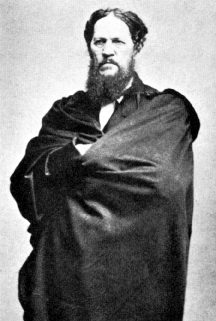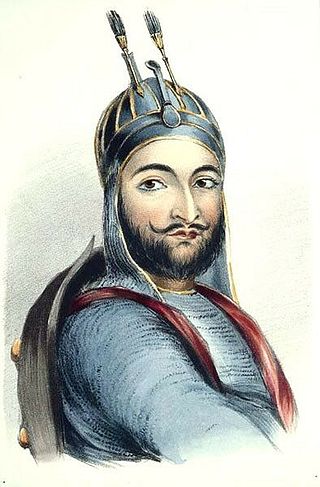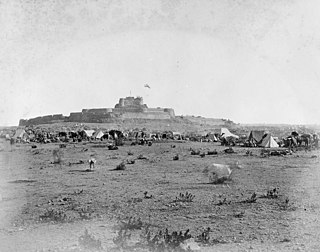
Emir Dost Mohammad Khan Barakzai, nicknamed the Amir-i Kabir, was the founder of the Barakzai dynasty and one of the prominent rulers of Afghanistan during the First Anglo-Afghan War. With the decline of the Durrani dynasty, he became the Emir of Afghanistan in 1826. He was the 11th son of Payendah Khan, chief of the Barakzai Pashtuns, who was killed in 1799 by King Zaman Shah Durrani.

Josiah Harlan, Prince of Ghor was an American adventurer who travelled to Afghanistan and Punjab with the intention of making himself a king. During his travels, he became involved in local politics and factional military actions. He was awarded the title Prince of Ghor in exchange for military aid. Rudyard Kipling's short story The Man Who Would Be King is believed to have been partly based on Harlan.

Sardar Mohammad Azim Khan Barakzai was a Pashtun noble who served as Afghan governor of Kashmir (1812–1819). He was the second son of the Barakzai chief Payinda Sarfaraz Khan, while his elder brother Fateh Khan was kingmaker and Vizier to Mahmud Shah Durrani. He was one of 21 brothers from eight mothers including his half-brother Dost Mohammad Khan who would later become Emir of Afghanistan.

Wazīr Akbar Khān, born Mohammad Akbar Khān and also known as Amīr Akbar Khān, was a Barakzai prince, general, emir for a year, and finally wazir/heir apparent to Dost Mohammad Khan until his death in 1847. His fame began with the 1837 Battle of Jamrud, while attempting to regain Afghanistan's second capital Peshawar from the Sikh Empire.

The Sikh Empire was a regional power based in the Punjab region of the Indian subcontinent. It existed from 1799, when Maharaja Ranjit Singh captured Lahore, to 1849, when it was defeated and conquered by the British East India Company in the Second Anglo-Sikh War. It was forged on the foundations of the Khalsa from a collection of autonomous misls. At its peak in the 19th century, the empire extended from Gilgit and Tibet in the north to the deserts of Sindh in the south and from the Khyber Pass in the west to the Sutlej in the east as far as Oudh. It was divided into four provinces: Lahore, which became the Sikh capital; Multan; Peshawar; and Kashmir from 1799 to 1849. Religiously diverse, with an estimated population of 4.5 million in 1831, it was the last major region of the Indian subcontinent to be annexed by the British Empire.

Hari Singh Nalwa was Commander-in-chief of the Sikh Khalsa Fauj, the army of the Sikh Empire. He is known for his role in the conquests of Kasur, Sialkot, Attock, Multan, Kashmir, Peshawar and Jamrud. Hari Singh Nalwa was responsible for expanding the frontier of Sikh Empire to beyond the Indus River right up to the mouth of the Khyber Pass. At the time of his death, the western boundary of the empire was Jamrud.

The Battle of Jamrud was fought between the Emirate of Afghanistan under Emir Dost Mohammad Khan and the Sikh Empire under Maharaja Ranjit Singh on 30 April 1837. Afghan forces confronted the Sikh forces at Jamrud. The garrisoned army was able to hold off the Afghans till Sikh reinforcements arrived to relieve them.

The Jamrud Fort is located beside Bab-e-Khyber at the entrance to the Khyber Pass from the Peshawar side in the tribal district of Khyber KPK, Pakistan. After death of Sardar General Hari Singh Nalwa, Khalsa Sarkar Wazir Jawahar Singh nominated Sardar General Gurmukh Singh Lamba as chief administrative and military commander to restore and consolidate the Khalsa army gains. General Sardar Gurmukh Singh Lamba was nominated as chief administrative and military commander to consolidate the gains of Khalsa Sarkar.

Diwan Mokham Chand was one of the chief commanders of the Sikh Empire. He conquered Attock from the Durrani Afghans in 1813 and subdued the Rajputs in the Hills of Himachal and in Jammu at Jasrota, Chamba, and Basroli. He also commanded one of the early Sikh expeditions to conquer Kashmir that ended in failure due to bad weather blocking the passes to the valley. Mokham Chand was born in a Hindu Khatri family origin.

The Battle of Nowshera was fought in Nowshera in March 1823 between the Yusufzai Afghans, supported by the Peshawar sardars, alongside Azim Khan Barakzai, the Afghan governor of Peshawar, where they would face the Sikh armies led by Maharaja Ranjit Singh. Azim Khan was a half-brother of Dost Mohammad Khan, future ruler of Kabul, and later Afghanistan. The battle was a victory for the Sikhs, successfully defeating Azim Khan's armies. This victory allowed them to begin to their occupation of the Peshawar Valley.

The Battle of Attock took place on 13 July 1813 between the Sikh Empire and the Durrani Empire. The battle was the first significant Sikh victory over the Durranis.
The siege of Multan began in March 1818 and lasted until 2 June 1818 as part of the Afghan–Sikh Wars, and saw the Sikh Empire capture the city of Multan from the Durrani Empire.
The Capture of Peshawar took place on 6 May 1834, between the Sikh Empire and the Peshawar Sardars, who was ruled by Sultan Mohammad Khan after being deposed by his brother, Dost Mohammad Khan, from his rule in Kabul.

Akali Phula Singh Nihang was an Akali Nihang Sikh leader. He was a saint soldier of the Khalsa Shaheedan Misl and head of the Budha Dal in the early 19th century. He was also a senior general in the Sikh Khalsa Army and commander of the irregular Nihang of the army. He played a role in uniting Sikh misls in Amritsar. He was not afraid of the British who at many times ordered for his arrest but were not successful. During his later years he served for the Sikh Empire as a direct adviser to Maharaja Ranjit Singh. He remained an army general in many famous Sikh battles up until his martyrdom in the battle of Nowshera. He was admired by the local people and had a great influence over the land and his settlement was always open to help the poor and helpless. He was well known and was a humble unique leader and prestigious warrior with high character. He was also known for his effort to maintain the values of Gurmat and the Khalsa panth.

The Afghan–Sikh wars spanned from 1748 to 1837 in the Indian subcontinent, and saw multiple phases of fighting between the Durrani Empire and the Sikh Empire, mainly in and around Punjab region. The conflict's origins stemmed from the days of the Dal Khalsa, and continued after the Emirate of Kabul succeeded the Durrani Empire.

The Standoff at the Khyber Pass (1834–1835) was a short conflict from May 1834 to May 1835 by the Sikh forces led by Maharaja Ranjit Singh and the Afghan forces led by Dost Mohammad Khan. The conflict began as the Sikh Empire expanded into Peshawar, deposing the Peshawar Sardars, while also supporting the deposed Durrani dynasty in their attempts to return to the throne of Afghanistan under Shah Shuja Durrani.
The Battle of Hasan Abdal took place on June 7, 1813, between the Sikhs led by Bhayya Ram Singh and Afghans led by Fateh Khan Barakzai at Hasan Abdal.

The Military campaigns of Hari Singh Nalwa were a series of conquests and battles in which the Sikh Empire commander Hari Singh Nalwa fought from 1807 to 1837. His first battle was fought against the Durrani Empire. With his help, the Sikh Empire managed to expand over a large land area, spanning from Jamrud to Tibet. He was killed in the battle of Jamrud at Khyber Pass in 1837.
The Expedition of Shuja ul-Mulk began in January 1833, whilst the siege of Kandahar began on 10 May 1834, and ended on 1 July 1834. The expedition was led by Shah Shuja Durrani, the deposed Afghan Emperor who wished to re-claim his throne. Shah Shuja rallied forces while in exile in the Sikh Empire and marched through Sindh to Kandahar, besieging it. Shah Shuja would be defeated by the Barakzai rulers of Kandahar and Kabul.

The Battle of Ali Masjid took place on the 27 July 1839 between the Sikh Empire and its allies against the Emirate of Afghanistan. In the battle, the Khalsa Army and its Afghan levies emerged victorious and subsequently marched into Kabul.















